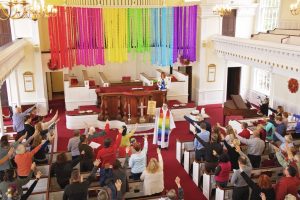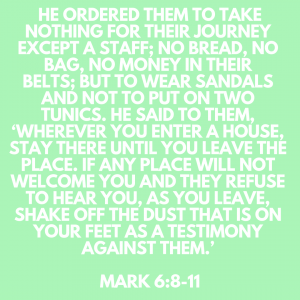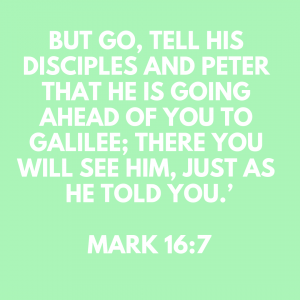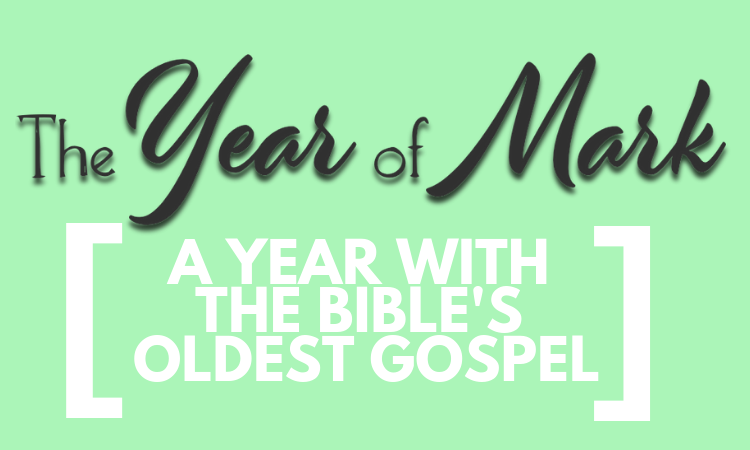“For I am not ashamed of the Gospel of Christ, for It is the Power of God unto Salvation to every one that believeth,” the Reverend Baxter began, as he settled in to preach the sermon at the founding of Westfield Church on October 19, 1715.[1] That day, a church was founded, its newly-minted minister ordained, and a course set that would better the lives of thousands of the faithful in the northeastern corner of Connecticut. At the heart of its founding and its ministry to the local community was a deep reverence for and appreciation of scripture. Three centuries later, Westfield’s continued commitment to its community is undeniable. But its commitment to scripture? Debatable. While the congregation has an unshakable love of Christ and is certainly not ashamed of the gospel, its overall biblical literacy was wanting.

We are the church that not only cares for the Heart of Killingly, but—in many ways—is the heart of Killingly. We serve thousands of meals annually to people in need; we stuff more than 12,000 Easter eggs for our annual Easter Egg Hunt; and we have redefined the holidays for our sleepy, little town with our beloved Victorian Christmas. After a year of devastating losses in our community including a tragic spate of deaths of students in local middle and high schools, Westfield emerged as the leading voice in guiding our community through its grief.
Learning the Bible Again
Despite a period of remarkable growth and numerical success, the spiritual life of Westfield was lacking. While the congregation’s commitment to caring for the heart of Killingly is inspired by our understanding of gospel commands, our knowledge of those commands within the totality of the scriptural narrative is virtually non-existent. Our worship is lively, engaging, thought-provoking and appropriately entertaining. It is the pulsing rhythm of our community, providing space for people to express their joy, their heartbreak, and everything in between in a spirit of authenticity.
And yet, as its pastor, I encountered my parishioners’ hunger for something more meaningful than engaging worship that ends in an hour. They wanted something that stayed with them through the week, something they could revisit on their own. They wanted something that wasn’t a tangential moment in their journey but a guiding force. The tool for that longevity became clear: scripture. But first, we had to show them how to use it.
In an effort to find an effective way to address the spiritual need at hand, it made sense to figure out just where the congregation was coming from. How much scripture did the people of Westfield Church know? How much about scripture did they know? Was there a baseline understanding of scripture we all shared? And if so, what was it?
I boiled those questions and others into two main categories: biblical authority and biblical literacy, then sent out a simple online survey. The first examined participants’ understanding of biblical authority. Simply put: how seriously do you take the Bible? The second sought to establish some kind of baseline regarding biblical literacy through a series of questions referencing books of the Bible, specific stories of the Bible, and where such stories are located in the overall corpus of scripture.
The survey assumed some basic familiarity with the stories but anticipated a significant lack of biblical knowledge in the pews. During this process, I realized that my own religious formation in the American South had shifted that baseline for me. My assumptions of even basic biblical knowledge (children’s songs at Vacation Bible School, for instance) were too optimistic. The survey results were, simply put, shocking. And yet, as I sifted through the results, I found myself asking a single question: Should I really be this surprised?
The survey indicated that the overwhelming motivator for my congregants’ attendance was the desire for community and the need to be part of something bigger. With nearly 85% of participants attending at least twice a month, it was surprising to see answers to the question “What is your understanding of biblical authority?” include “?,” “Beats me,” “Zero understanding,” and a non-committal, “It is what it is.” Interestingly, only 8.6% of participants responded that they read the Bible daily. It is no surprise, then, that when confronted with the notion of biblical authority, the overwhelming majority of our participants did not even know where to start.
 Even more troubling were the responses to “Does the Bible influence your day to day life? If so, how?” Many answered that the Bible did inspire them in some way, yet many of those responses were tepid, lacking any substantive examples of concrete ways the Bible influenced their day to day lives. While it is difficult to read emotion into typed answers, it was clear that some responses were bordering on embarrassed that the Bible didn’t influence their lives as much as they felt like it should.
Even more troubling were the responses to “Does the Bible influence your day to day life? If so, how?” Many answered that the Bible did inspire them in some way, yet many of those responses were tepid, lacking any substantive examples of concrete ways the Bible influenced their day to day lives. While it is difficult to read emotion into typed answers, it was clear that some responses were bordering on embarrassed that the Bible didn’t influence their lives as much as they felt like it should.
As my parishioners reflected on their experience of the survey, many indicated that while the stories we read on Sunday morning from the Revised Common Lectionary are not entirely unfamiliar, how they fit together–not just within the gospels they originate from but also in the larger context of God’s story—is largely lost to our congregation. Almost universally, my congregants wanted an intentional exploration of scripture and what it means in a modern context. They wanted to know what the stories in the Bible are and what those stories say to them today.
I found myself feeling a new pressure as the pastor of Westfield Church. While I knew that I was the primary biblical scholar and interpreter for my congregation, I had no idea the extent to which they relied on me to connect their lives to the story of God revealed in Holy Scripture. The needs became clear: Westfield’s congregants carried a deep desire for intentional biblical formation from the pulpit and a deep hunger to understand their story as part of God’s larger story of faith.
The Year of Mark
On the second Sunday of July 2017, I read the first verses of the Bible’s oldest and shortest gospel during Sunday morning worship. For months, I had been working out the details for our first-ever sermon series. Rather than a short sprint through an Epistle or a month on a certain topic, I chose to start with the central story of the Christian faith—the story of Jesus. It was no small undertaking. We were to take fifty-one weeks to walk through the gospel of Mark in worship.
My goal was three-fold. First, I hoped my congregation would gain increased knowledge of the stories found in Mark. Many of my parishioners indicated they knew individual stories found in the gospels, but those same parishioners were unable to order those stories not just in Mark’s sequence but into any kind of narrative arc matching any of the gospels. By working through Mark sequentially, I hoped to empower them to grasp the gospel narrative as a whole.
 Mark was an obvious choice to achieve this goal for the simple reason that it has the fewest stories—it’s nearly 60% the length of the other synoptic gospels.[3] Widely thought to be written from a larger oral tradition, the stories in Mark are dense, meaningful, and brief, packing a punch when it comes to spiritual insight.[4] I hoped that using the Markan version of key stories shared among the gospels would keep those stories easier to understand, reference, and sequence into an overarching narrative for my congregants.
Mark was an obvious choice to achieve this goal for the simple reason that it has the fewest stories—it’s nearly 60% the length of the other synoptic gospels.[3] Widely thought to be written from a larger oral tradition, the stories in Mark are dense, meaningful, and brief, packing a punch when it comes to spiritual insight.[4] I hoped that using the Markan version of key stories shared among the gospels would keep those stories easier to understand, reference, and sequence into an overarching narrative for my congregants.
It wasn’t just about being able to enumerate the order of the stories. The Year of Mark was an effort to help my congregants see how those stories built on one another, adding layers of meaning to stories that alone might indicate one interpretation but when placed within the larger narrative point to another. While the order was important, it was also essential for them to grasp the content and the continuity of the gospel.
My second goal was to deepen their understanding of the gospel message found in Mark by encountering it in its entirety. Through intentional continuity of presentation, I hoped that they would learn how the stories of scripture are far more potent when considered through the lens of the totality of scripture. Like all the gospels, Mark’s stories build one on another. Ultimately, the gospel message isn’t found in any singular parable, miracle, or teaching but in the accumulation of them in their totality.
In this way, Mark was a stand in for the whole of scripture. I wanted my congregation to gain a deeper understanding of the complexities of scripture, but in a way that was both palatable and digestible for my church of non-biblical scholars. I hoped that by using Mark as a case study, it would point to larger truth about the texts we claim as God’s word and about God.
Finally, I hoped that my parishioners would be able to understand Mark’s gospel not just as a history of Jesus and his first followers but as a text that invites them to become a part of the ongoing story of God’s faithfulness. I wanted them to learn the details of the gospel and find the ways their lives—being lived millennia later—are already woven into those stories.
The Year of Mark in Action
The Sunday after the 2016 election, I had church members weeping in their pew sitting beside church members who were celebrating. Starting The Year of Mark less than a year following such a defining day in our modern political story, proved to be an effective tool from a homiletical standpoint. The stories Mark offers, along with their particular brand of political and religious intrigue, became a natural entry point into meaningful conversations with my politically-divided yet deeply-committed-to-each-other congregation.
Throughout the year, I was able to draw parallels to Jesus, his disciples, and their struggles in Mark’s gospel with modern day challenges and questions, but two instances stand out as being particularly successful. While these weren’t sermons I would submit for critical analysis or appraisal, they did—if subtly—effectively address issues congregants were having and challenges they were facing. By addressing it from the pulpit, I was able to validate their emotions toward challenging situations while also offering a way forward.
 One opportunity appeared on the second Sunday of October. The passage for the day was the first twenty-nine verses of Mark 6. There is a lot packed into those thirty or so verses. Jesus issues his famous commentary on prophets (“Prophets are not without honor, except in their home town, and among their own kind, and in their own house.”); he sends the twelve out in pairs, ordering them to not take anything with them and to move on if they are not welcomed (“If any place will not welcome you and they refuse to hear you, as you leave, shake off the dust that is on your feet as a testimony against them.”); and John the Baptist is beheaded.
One opportunity appeared on the second Sunday of October. The passage for the day was the first twenty-nine verses of Mark 6. There is a lot packed into those thirty or so verses. Jesus issues his famous commentary on prophets (“Prophets are not without honor, except in their home town, and among their own kind, and in their own house.”); he sends the twelve out in pairs, ordering them to not take anything with them and to move on if they are not welcomed (“If any place will not welcome you and they refuse to hear you, as you leave, shake off the dust that is on your feet as a testimony against them.”); and John the Baptist is beheaded.
Passages like this one were a unique challenge of The Year of Mark. In order to make the entire gospel fit into a year, there were days I had to expand the Sunday morning passage beyond the obvious pericope. This meant that, at times, I had to make hard choices when preparing for Sunday. My time was limited. If there were three major movements in a scripture—like this one—trying to preach all three for the sake of narrative would limit my ability to preach a meaningful sermon that had the potential to connect with my congregants.
That particular week, several of my congregants had come to me with a challenging situation. There were members of our town they were trying to assist. My well-intentioned, if naive, members were entirely disillusioned by their realization of the depth of systematic poverty in our community. They were overwhelmed by what they had agreed to do and were worried that their obligation was spiraling out of control.
So that Sunday, rather than pontificate on Jesus’ stirring remarks on prophets or the tragic beheading of John the Baptist, I set out to give my members advice:
Don’t over pack. Jesus gives his disciples packing instructions. Only a staff and sandals, he tells them. No food, no bag, no money, no extra clothes. If you’re like me and you tend to overpack, then you know the worst part of traveling with your overstuffed bag is getting that bag from the baggage carousel at the airport to the car or from the car to your hotel room. It’s heavy, so you kinda swing it out, thinking you’re using leverage to your advantage which can sometimes cause you to fly behind it. Have you seen that before? People whose bags get away from them like that? It’s kind of funny until it happens to you. Here’s Jesus’ advice: don’t over pack. That is, don’t fill your life up with such busy-ness that you can’t respond to God’s call in your life. Don’t take on other people’s stuff. Man, that’s hard. I am so bad at it. But here’s the thing, I’ve already got my own baggage. I don’t need other people’s, too! So that’s the second task: Don’t overpack.
Of course, within the confines of this work and on my own, it’s difficult to fully express the effectiveness of such sermons and The Year of Mark in total. But members of Westfield were quick to offer their feedback along the way and at its conclusion. The effective completion of the original goals is dependent on who you speak with, their overall participation, and their willingness to offer feedback. It seems that many expanded their biblical literacy and gained a more meaningful sense of their own faith by deepening their understanding of how God’s story is woven with theirs.
Presenting the gospel of Mark in sequential order was a major piece of the overall project. One member commented, “I’d heard Bible stories before of course, but never in an organized, adult way. I’d never taken and studied Jesus’ life and times in a consistent and straight forward way and our study of Mark was a perfect way to do that.” Another parishioner and Bible study participant reflected, “It [The Year of Mark] absolutely helped me read and understand Jesus’ life ‘in sequence.’ Through The Year of Mark I feel like I finally understand who Jesus was and why he was (is) so important.”
It’s clear that The Year of Mark, at least on some scale, achieved its goal of helping members of Westfield Church understand the overall narrative of the gospel through the study of Mark. Many commented on their newfound ability to connect the stories of Jesus they’d heard all their lives to each other. What’s more is that they were able to connect those stories to their own lives.
Another hoped for outcome of The Year of Mark was to deepen the spirituality of our members. One participant shared how The Year of Mark allowed her to experience her faith more deeply. “I have been surprised by the emotionally moving moments just sitting in church. As a (perhaps uptight) WASP, I’m glad to be more in touch with this side of me which I’ve never really accessed adequately before. Historically, I don’t cry easily. A year later, I feel like I’m more understanding of references that are made in sermons and also specifics in the church year.”
Another commented on a newly found sense of belonging thanks to The Year of Mark. A Japanese immigrant, she joined Westfield in a particularly turbulent time in her family which ultimately resulted in a divorce. She was introduced to Christianity (in the formal sense) and eventually baptized at Westfield. We have been the guiding force in her spiritual formation. She offered, “I feel that I’m far more educated in terms of gospel and religious understanding. The Year of Mark helped me to understand Jesus: what it means to live like him through his actions and what he sacrificed for us. I am more ‘religious,’ I can say that for sure. I certainly try living by what I had learned from The Year of Mark. It was very meaningful on my end.”
Six months after the end of The Year of Mark, I asked for feedback from members of my congregation. “Do you know more about Mark now?” I asked. “Did it deepen your faith? Did you notice anything new about the Bible? Do you feel more equipped now to talk about the Bible, or even just Mark, than you did before?”
A Changed Faith
Mark was a desperate gospel writer. He had a story to tell—an urgent one that he hoped could become a balm and a guide through the harrowing and complicated political times early Christians were living through. Those themes resonated deeply with my congregation and proved the power of the gospel’s timelessness. Not only did our year-long exploration of Mark expand my congregation’s biblical literacy, it also shaped our corporate theology in a unique way.
The shorter ending of Mark compels us not to wait for the risen Christ, but to go find him where we first met him. For the disciples, that was Galilee. But for us that’s very likely not in the church, but out in the world. This single theological understanding of where we’re called to meet Jesus has fundamentally altered our mission as a congregation. No longer are we the insular congregation solely intent on our survival. We’ve become the Heart of Killingly—a congregation striving to care for those we meet outside our walls, not just inside of them. While Mark is not responsible for that shift alone, our study of his gospel pointed us in the right direction.
It is impossible to gauge The Year of Mark’s overall success, but it’s clear that it had an impact both on an individual level and institutionally. We were a different church before we started this journey than we are now, after it. And members of our congregation are equipped to engage the Bible in new ways thanks to The Year of Mark. Its greatest benefit, however, was how it inspired my congregation to broaden not just their scriptural horizons, but their spiritual ones, too. 
After 51 weeks, the most meaningful learning wasn’t the order of the narrative, nor the details of the story. The holiest lesson we shared in big ways and small was that the Gospel is bigger than any one telling of it. It’s something that compels us beyond our comfort zone and into a new world of meaning. It’s an invitation into a relationship—not just with Jesus, but with ourselves, with each other, with the Church Universal, and with our congregation in our little corner of Connecticut. For us faithfulness isn’t held by the confines of the written word, nor the chains of tradition. Instead, we’re still writing the end of the story all while we follow where Jesus leads, trusting the words of the Angel in Mark 16: “But go…he is going ahead of you to Galilee; there you will see him, just as he told you.”
[1] S.S. Matthews, Harry E. Back, and George B. Guild, Manual of Westfield Congregational Church: Danielson, Connecticut, 1715-1905 (Boston: Frank Wood, 1905), 7.
[2]While the original assessment targeted two main questions (biblical literacy and biblical authority), it became clear that tackling both questions on a broader scale within the same congregation and at the same time would be too much. Before engaging individual and congregational notions of biblical authority, it seemed prudent to first address the Bible as a piece of literature itself. By gaining even a baseline understanding of what is in scripture, we might then be able to more deeply explore what weight or authority we give it.
[3] Carl R. Holladay, A Critical Introduction to the New Testament: Interpreting the Message and Meaning of Jesus Christ (Nashville: Abingdon Press, 2005), 107.
[4] Dewey, “The Gospel of Mark as an Oral/Qural Narrative: Implications for Preaching,” 7.

This is so well done and inspiring. I will be praying for you this week. Traveling mercies.